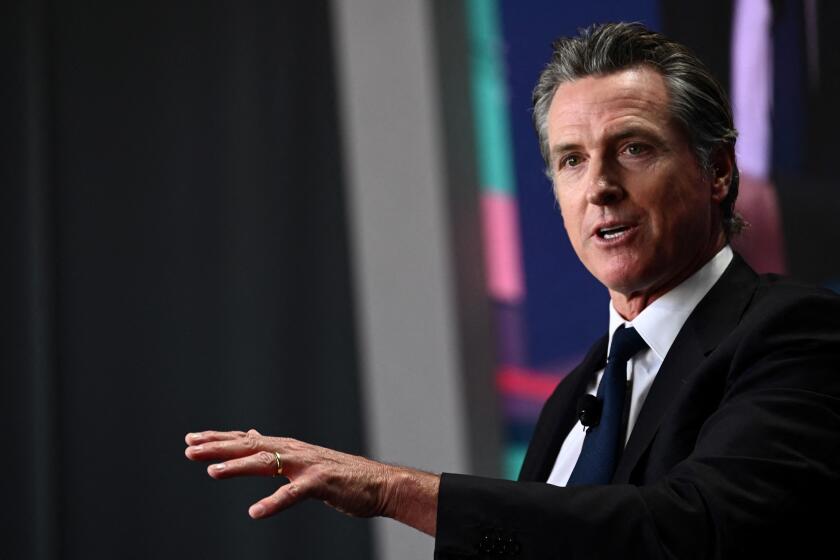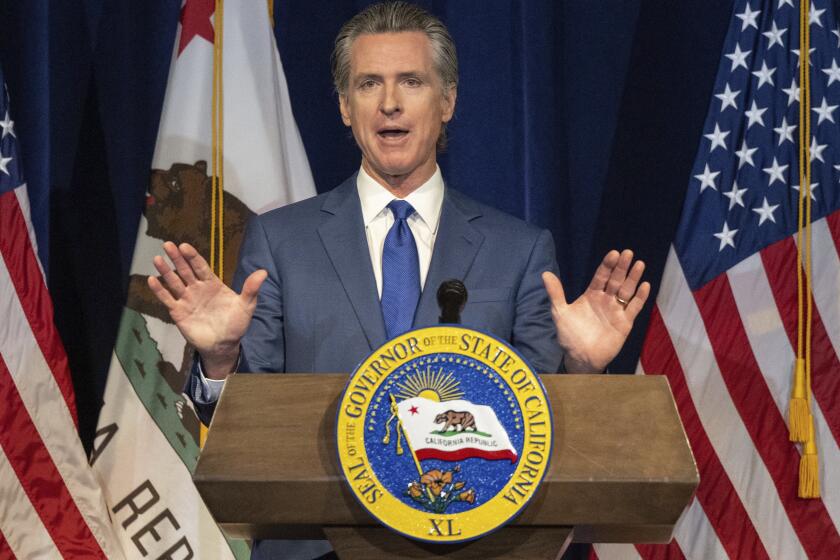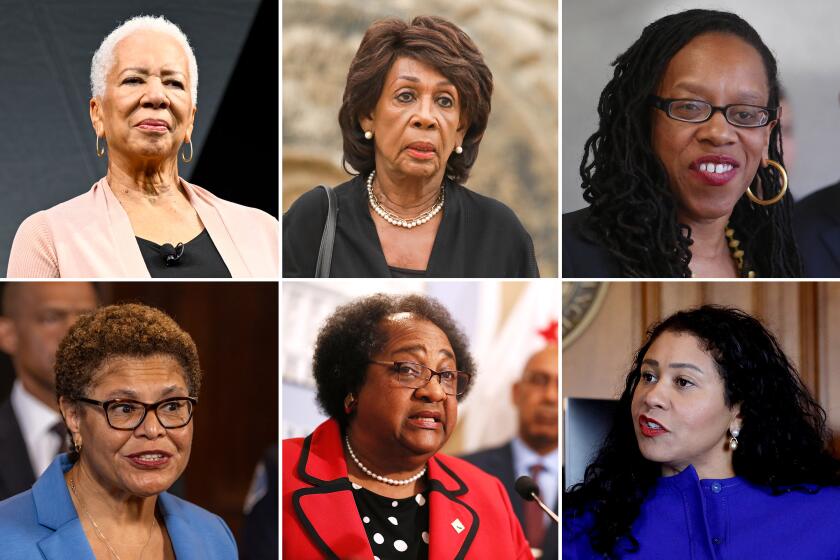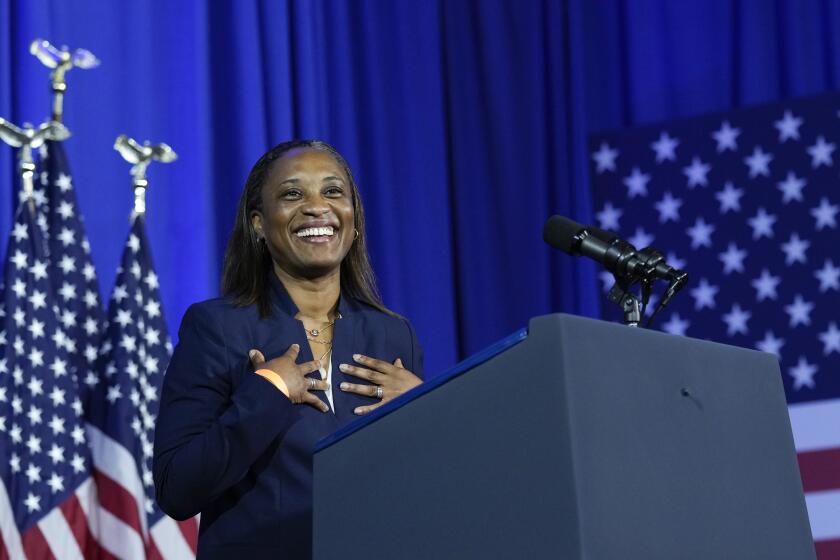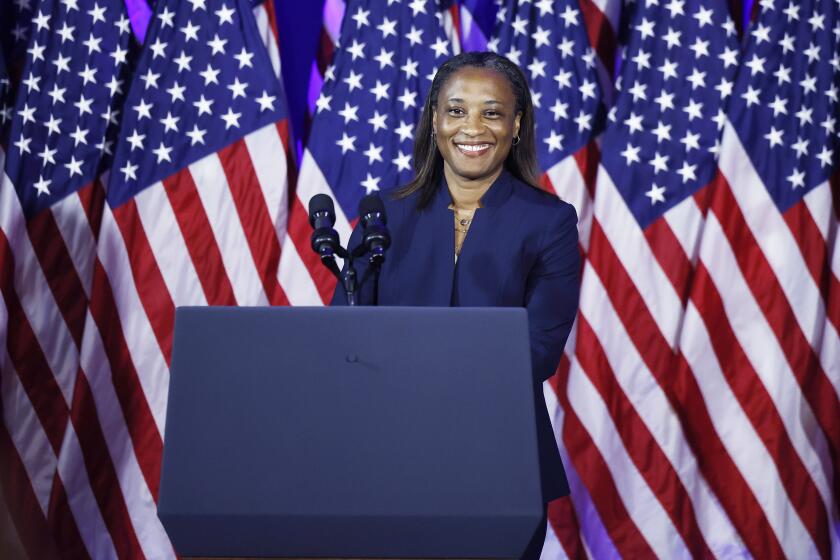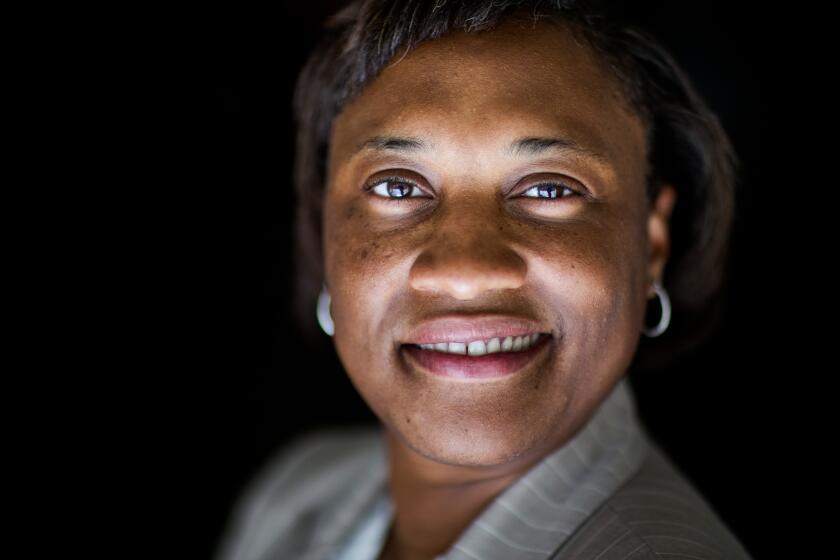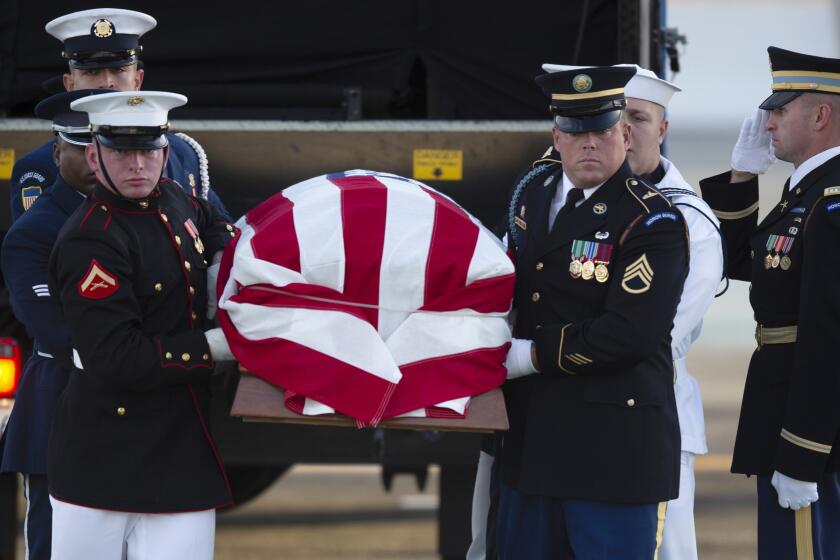From Dianne Feinstein’s death to the rise of Laphonza Butler: 3 momentous days in California
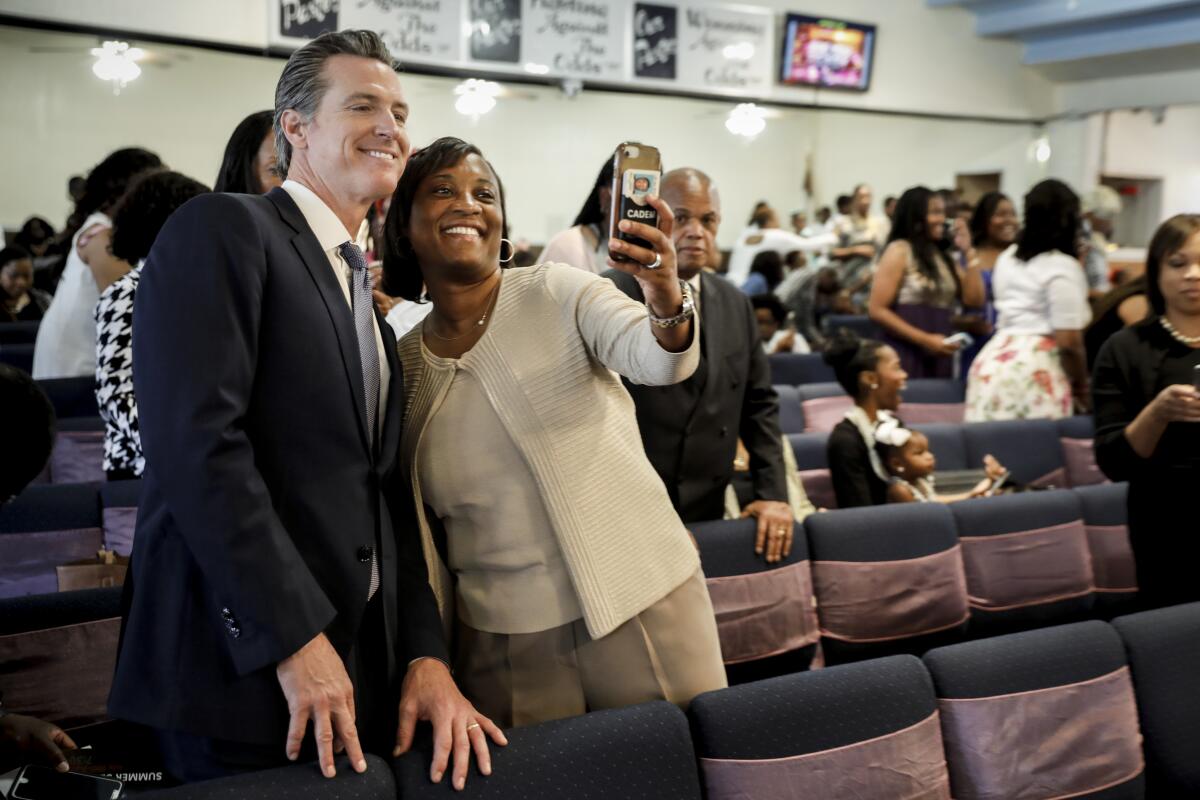
- Share via
The news jolted California on Friday morning: The state’s legendary senator, Dianne Feinstein, had died at age 90.
Her death launched an outpouring of mourning and memories for the towering figure.
But it also created a more basic political quandary: Whom would Gov. Gavin Newsom pick to replace her?
This was the question with which Newsom had been grappling for more than a year as Feinstein’s health dramatically deteriorated and some called for her to step down.
Supporters of Rep. Barbara Lee mount a campaign for her to be Gov. Gavin Newsom’s nominee to fill Sen. Dianne Feinstein’s post.
With several prominent Democrats already vying to win Feinstein’s seat in 2024, Newsom made a choice that would dictate his list of candidates.
Here is a look at how the 72 momentous hours following the senator’s death went, from reporting in The Times.
Who were Newsom’s choices?
Newsom’s decision on a potential appointment has some history.
Three years ago, he promised to appoint a Black woman to the U.S. Senate if a vacancy opened.
The 100-member Senate does not include a Black woman, a void left when California’s Kamala Harris vacated her seat in 2021 to become vice president and Newsom tapped then-Secretary of State Alex Padilla to the coveted post.
Padilla, a longtime political ally, made history as California’s first Latino senator. At the time, Newsom faced criticism for not selecting a Black person, so he pledged the next opening would go to a Black woman.
California’s governor vowed to pick a Black woman to fill the vacancy in the Senate. But he won’t get many takers without the ability to run again.
What role did the Senate race play?
Newsom also was under pressure to not unduly influence the hotly contested 2024 U.S. Senate race. He later announced no successor would be from among the candidates running to replace Feinstein.
Rep. Barbara Lee of Oakland is the only Black woman among several high-profile candidates vying to take Feinstein’s seat in 2024.
In the wake of Feinstein’s death, some called on Newsom to change his stance and tap Lee.
With the death of Sen. Dianne Feinstein, Gov. Gavin Newsom now must decide who will fill her U.S. Senate seat until the next election.
“The most qualified person on day one to fill the legacy of Sen. Dianne Feinstein is none other than Congresswoman Barbara Lee,” Congressional Black Caucus Chairman Rep. Steven Horsford said Sunday in an interview with MSNBC.
The caucus also sent Newsom a letter making the case for Lee, and Horsford said he had talked to Newsom about it by phone and in person.
“We’re asking him to understand the moment of this appointment not only for the people of California, but for the people of the United States,” Horsford said.
As the weekend wore on, Newsom faced more criticism for his decision to appoint a short-term caretaker. Times columnist Erika Smith on Saturday described his pitch to Black candidates this way: “Hey, you there, Black woman. Can you keep this seat warm for a few months? Vote and do Senate stuff. You know, just until we elect a white person to replace you?”
A UC Berkeley poll in September found Democrats Reps. Adam B. Schiff of Burbank and Katie Porter of Irvine are neck and neck, with support from 20% and 17% of likely voters, respectively. The two have sizable leads over Lee, who sits at 7%.
Despite several months of campaigning, Lee remains less well-known, with half of likely voters having no opinion of her. Although she is the only Black candidate in the race, she trails among likely Black voters, with 16% support, behind Schiff’s 30% and Porter’s 21%. Newsom hasn’t endorsed anyone in the Senate race.
Political observers said the stakes were high for the governor.
“Newsom is in a pickle here,” said Steven Smith, a professor of political science at Washington University in St. Louis.
Did Newsom’s stance change?
On Sunday, Newsom’s office did offer a clarification, saying whomever he selected would be free to run for the seat in 2024.
“If that person decides she wants to seek a full term in 2024, then she is free to do so. There is absolutely no litmus test, no promise,” Newsom spokesman Anthony York told The Times.
However, mounting a successful statewide campaign just six months before the March primary, when other candidates have been fundraising all year, would be a formidable challenge. While incumbency is a powerful force in elections, there is no guarantee that Newsom’s appointee would be a viable candidate.
Butler is a Democratic strategist who rose to prominence in the labor movement and previously was an advisor to Kamala Harris’ presidential campaign.
How did the choice come down?
With Democrats’ slim majority in the Senate, Newsom was under pressure to name his pick quickly.
So on Sunday night, he announced that Laphonza Butler, a Democratic strategist who rose to prominence in the labor movement and who is also the president of Emily’s List, would fill the void.
Butler, a lesbian, will be the first out person of color to serve in the Senate and the first LGBTQ+ senator from California.
Gov. Gavin Newsom appointed Laphonza Butler to fill the Senate seat that was held by Dianne Feinstein, who died Friday. Who is Butler?
“An advocate for women and girls, a second-generation fighter for working people, and a trusted adviser to Vice President Harris, Laphonza Butler represents the best of California, and she’ll represent us proudly in the United States Senate,” Newsom said in a statement.
“As we mourn the enormous loss of Senator Feinstein, the very freedoms she fought for — reproductive freedom, equal protection, and safety from gun violence — have never been under greater assault. Laphonza will carry the baton left by Senator Feinstein, continue to break glass ceilings, and fight for all Californians in Washington, D.C.”
Little is known about Newsom’s process in selecting Butler.
Some names that sparked speculation included California Secretary of State Shirley Weber; San Francisco Mayor London Breed; civil rights leader Angela Glover Blackwell; and human rights activist Lateefah Simon, who is running to replace Lee in Congress.
Los Angeles County Supervisor Holly Mitchell and U.S. Rep. Maxine Waters (D-Los Angeles) said they are not interested. A representative for L.A. Mayor Karen Bass shot down speculation earlier this year that she might consider the job.
Laphonza Butler will bring a fresh perspective to the Senate. But Gavin Newsom should have kept his pledge to name a caretaker to replace Dianne Feinstein.
Who is Laphonza Butler?
Before joining Emily’s List — a political organization dedicated to electing women to political office — Butler served as director of public policy and campaigns at Airbnb. She also partnered at the political consulting firm SCRB Strategies (now Bearstar Strategies), whose clients included Newsom, former Oakland Mayor Libby Schaaf and then-Sen. Kamala Harris. The firm is run by the governor’s veteran strategists Ace Smith, Sean Clegg and Juan Rodriguez.
Butler also served for more than a decade as president of Service Employees International Union Local 2015, which represents more than 325,000 nursing home and home-care workers throughout California. SEIU Local 2015 is the largest union in California and the largest local representing long-term care workers in the country.
She also was a senior advisor on Harris’ presidential campaign.
In 2018, Butler was appointed as a UC regent by then-Gov. Jerry Brown, a post she held until 2021. She has served on the board of the Children’s Defense Fund, a national child advocacy organization; political action committee BlackPAC; and the Bay Area Economic Council Institute think tank. She’s a former director for the board of governors of the Los Angeles branch of the Federal Reserve System.
Butler was born in Magnolia, Miss. Her father died after a series of heart attacks when she was 16, leaving her mother to work as many as three jobs at once to support her three children.
She received her bachelor’s degree in political science from Jackson State University — a historically Black college — where, she told The Times’ Mark Z. Barabak in 2021 that she was inspired by her instructors, many of whom were veterans of the civil rights movement. They instilled in her a bent toward activism and a commitment to social justice, she said.
“What are you doing for freedom? That was always the question,” Butler told Barabak. “What are you doing for freedom today?”
Butler moved to California in 2009 after serving as a labor organizer for nurses in Baltimore and Milwaukee, janitors in Philadelphia and hospital workers in New Haven, Conn.
The public can pay its respects and sign a condolence book on Wednesday, before the late senator’s funeral service.
What is next?
Mourners can pay their respects to Feinstein this week when her body lies in state at San Francisco City Hall, where her political career began.
The public can gather Wednesday to say goodbye to the long-term California senator as well as sign a condolence book from 9 a.m. to 7 p.m., her office said.
The late senator’s funeral will be a private affair Thursday at the War Memorial and Performing Arts Center in the Herbst Theatre. It will be livestreamed and broadcast for public viewing at San Francisco City Hall.
Meanwhile, Butler could be sworn in as early as this week.
Times staff writers Laurel Rosenhall, Hannah Wiley, Taryn Luna, Kevin Rector, Susanne Rust, Noah Goldberg and Sarah Wire contributed to this report.
More to Read
Sign up for Essential California
The most important California stories and recommendations in your inbox every morning.
You may occasionally receive promotional content from the Los Angeles Times.
